For me, two different things happen when I use that shuffler,
one - at the phantom the center it becomes easier to understand speech (noted that I don't use my cross-talk and mid/side EQ which has a similar effect) and is slightly more stable positioned in the center, but it also does move back a little. I didn't particularly favor it for music.
two - it becomes easier for me to point out the position my speakers in side panned sounds, something that's not happening without that using the shuffler. (eyes closed, pointing at where the sound comes from, without the shuffler, using my own solutions the speaker position isn't revealed, it images where the music puts it, speakers disappear as an obvious sound source)
I did not keep that shuffler for both of those reasons. I could imagine it coming in handy for Home Theater, that's what it was aimed at. However, my home brewed solutions that I have created over time simply work better.
People often talk about the sound being dull after they have equalized it to be near perfect. I always think that they simply stopped a little too early, as it isn't a bad sign. But there are some factors that stand in the way to unleash the sound. That thread from Pano goes into the theory part of that flaw of Stereo sound. Most obvious in the absence of early reflections, in fact, it is difficult to detect if there are reflections. But once you get past that flaw, dull certainly isn't the description I would give the EQ-ed sound 😀.
one - at the phantom the center it becomes easier to understand speech (noted that I don't use my cross-talk and mid/side EQ which has a similar effect) and is slightly more stable positioned in the center, but it also does move back a little. I didn't particularly favor it for music.
two - it becomes easier for me to point out the position my speakers in side panned sounds, something that's not happening without that using the shuffler. (eyes closed, pointing at where the sound comes from, without the shuffler, using my own solutions the speaker position isn't revealed, it images where the music puts it, speakers disappear as an obvious sound source)
I did not keep that shuffler for both of those reasons. I could imagine it coming in handy for Home Theater, that's what it was aimed at. However, my home brewed solutions that I have created over time simply work better.
People often talk about the sound being dull after they have equalized it to be near perfect. I always think that they simply stopped a little too early, as it isn't a bad sign. But there are some factors that stand in the way to unleash the sound. That thread from Pano goes into the theory part of that flaw of Stereo sound. Most obvious in the absence of early reflections, in fact, it is difficult to detect if there are reflections. But once you get past that flaw, dull certainly isn't the description I would give the EQ-ed sound 😀.
I fully understand your choices. Do you by any chance have a .wav file that I could try and convolve - or are they perhaps speaker specific? 🙂
//
//
I think I also now hear it as the width of the scene become limited to the speakers with the shuffler - so narrower but not further away really... It's hard to be precise about this...
Perhaps narrowing gives also an impression of longer distance to source..
//
Perhaps narrowing gives also an impression of longer distance to source..
//
But I wasn't totally pleased with the highs prior to that experiment so... The WGs with the drivers are extremely resolving to the point I'm not sure I have heard such resolution before - but there is more to a system than resolving power ...
I feel you. But I am the least scientific about the whole matter, though I do measurements. My >intuition< with the unpleasing highs is this is more a result of a two-sectioned DI profile: significantly wider below 1k, significantly tighter above. In Geddes' approach, everything was justified due to a psycho-acoustical preference of less reflections in the range above 1k. But his designs were based on big woofers with less directivity. This two-step signature might lead to our issue with the peculiar perception of the highs, in my laymen reasoning.
We should want to retain the resolving qualities, not diminishing them. But I have the impression you are working against this uncompromized clarity, which is so nice to have with waveguides.
Aren't big woofers more beaming? Anyways, I didn't find the fins to lessen the clarity and resolution - rather the opposite as some hash and gargle seem to have disappeared. Now, I feel these WGs are still to directive so these are not my endgame speakers in any way but I have to say that some of its properties I really admire 🙂
The highs are now as I hear them with good recordings really fantastic. But on many recordings they are not - making me wish that all recording and mastering engineers had thus kind of HF available when they did their production.
//
The highs are now as I hear them with good recordings really fantastic. But on many recordings they are not - making me wish that all recording and mastering engineers had thus kind of HF available when they did their production.
//
Nice to hear you enjoy the subjective results. Looking forward to hearing from your impressions with a less directive waveguide, as in the recent Purifi prototype.
Yes, I meant that the bigger woofers in Geddes system were even mitigating the step issue better than designs like ours. I used a 12-inch first, then a 10-ich woofer. This makes the issue more prominent.
Yes, I meant that the bigger woofers in Geddes system were even mitigating the step issue better than designs like ours. I used a 12-inch first, then a 10-ich woofer. This makes the issue more prominent.
If there were no HOMs, the insert would have no effect.
HOMs can share a common centre (the horn axis), like this..
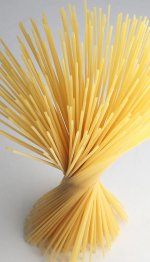
If your insert was symetrically mirroring in an angularly continuous way, then it would have no effect (although it is physically impossible to mirror all rotations at the same time in the same space).
Your insert has to be adding off-centre reflections. From that I'm inclined to assume spreading of some sort, perhaps some kind of HOM diffusion?
HOMs can share a common centre (the horn axis), like this..

If your insert was symetrically mirroring in an angularly continuous way, then it would have no effect (although it is physically impossible to mirror all rotations at the same time in the same space).
Your insert has to be adding off-centre reflections. From that I'm inclined to assume spreading of some sort, perhaps some kind of HOM diffusion?
Do you by any chance have a .wav file that I could try and convolve - or are they perhaps speaker specific?
I don't use a FIR filter for what I do, but perhaps I could apply such changes to a selected recording?
It probably differs with differing listening setup/angles etc, but we could try. At least two other line array users did experience the benefit of it.
I guess I could create a few versions, trying to keep total energy/SPL close to the same. Would you have a recording in mind? Hopefully with plenty of low end as well? As you know, I mainly listen to studio recordings, I have plenty of those I could use/choose from.
Thanks! I'll ponder that and get back with some suggestions. A slight "problem" is that I mainly judge my system using acoustic recordings - mostly orchestra 🙂 but I play such as well of course... like:
The Island Where I Come From
Laurie Anderson
Life on a String
//
The Island Where I Come From
Laurie Anderson
Life on a String
//
Yes. Have you heard it? I haven't found a subjective great correlation between DR and album SQ really - but cant say I have made a scientific investigation ;-D
//
//
I'll look for it.
Hmmm that's a lot more modern production than I expected.
Could you PM me?
I have heard some bad examples of low dynamic range where I was familiar with an older version that did have a wider range. On the other hand I've heard many songs with limited dynamic range that were enjoyable. I do prefer a Dr of about 12 and up (if available), which is why I look for it on that database. Usually it does have a more natural sound, less compression used.
No matter what I play, I use R128 volume leveling so I won't notice one song being louder than another. So I won't judge a song purely based on that number alone. Differences are audible though. Especially if you have a reference of that same song with more dynamic range. E.g. lots of remasters that simply fail.
Could you PM me?
I have heard some bad examples of low dynamic range where I was familiar with an older version that did have a wider range. On the other hand I've heard many songs with limited dynamic range that were enjoyable. I do prefer a Dr of about 12 and up (if available), which is why I look for it on that database. Usually it does have a more natural sound, less compression used.
No matter what I play, I use R128 volume leveling so I won't notice one song being louder than another. So I won't judge a song purely based on that number alone. Differences are audible though. Especially if you have a reference of that same song with more dynamic range. E.g. lots of remasters that simply fail.
Hi,I have now lived and listen a lot to these the past days. I still very much enjoy them and I'm certainly glad I built them. But all isnt/wasnt completely dandy - is it ever 😉
Yes- there was harshness in the midrange. So the old CD / wg problem? I dont know. Its like a shsss bright guurlgle on choir and massed strings - impossible to live with. I think it can what is circled in the "bugger" attachement - it could be energy transfer in both any direction... its surely is in the cover region.... For the Hornflower, I fixed 2/3 of it by some very simple measures and I have one or two left up my sleeve.
- The cavity between the horn and the flower - filled it up with fleece - better.
- Made a roll of fleece which on one of the long sides, I cut small leafs - these kind of prolonged the round-over of the wg towards the flower - better still.
- The hard brutal PLA/Concrete/Steele meeting between the flower and the WG in the area of the throat - I used felt to to form a gasket which the WG now rest mostly on to decouple them from each other - that made 2/3. Very nice thank you.
I will make some more investigations around this - I isolated it by playing a foul passage and did it with only LP or HP section. It was the HP for sure. But there seem to be a combination of mechanical interaction and diffraction that was the reason.
Remaining things:
- The tube inside the flower which the CD / WG sit in will be dressed with the same felt mat on both inner and outer sides i.e. facing the bass drivers and the CD/WG (the latter could be made better than my quick fixe above).
- Rolls on the four tops of the flower to mitigate diffraction by absorbing HF thus hindering it reaching the 4 eye-brows and at the same time support some covering of the backside for some improved WAF.
- I will make the petal leafs a bit more ordered and permanent. Color and style is under consideration...
I'm enjoying them immensely and they are a real hit - super duper. As I write this I listen to Aja and I hear a lot of how it was played - especially in the bass actually - thet bassist plays many more notes than I knew - quick little wonderful arpeggios that I haven't even spot in my HPs :-D
I will get back on my main takeaways from this bild + one aspect that will never be possible fix (but it's ok...).
View attachment 1078330
//
I've been pondering about some weird sound somewhere on treble on my system and only lately started paying attention to it again. It is likely that my printed ST260 has audible resonance, as it is quick proto and there is audible ring when knocked.
When I got the waveguides I tried to address possible ring by taping some damping behind it, like you with the fleece, but couldn't say if there was a difference. Also measurements didn't seem to show much, at least nothing obvious, so didn't pay too much attention to it until lately.
Turns out there is quick and simple test to evaluate audibility of ringing on such freestanding waveguides: just stand in front of the speaker, play music and listen and hold the rim of the waveguide (or any part of the waveguide) with your fingers to tame any resonance 😀 To make sure your arms do not change the sound keep them still, like rest of your torso, just pinch your fingers to dampen resonances, and relieve to let it resonate again. There seems to be quite much coloration in my case at least, one piece petg print with 20% infill if I remember. For some reason, the audible difference seems much greater than what measurements show. Perhaps I took wrong measurements, perhaps I didn't zoom close enough, perhaps it is below noise floor or something, or the issues is such that it averages out for mic but not for ear. I should try mic measurement with the finger technique, as there is confirmed audible difference perhaps it is possible to now see it on some graphs as well, to get better understanding on magnitude of things.
Anyway, it is easy to think good measurements mean system performs well, even though there can be issues under the surface which take away from the performance. Same for box noise for woofers.
Remembered your post so thought to post about it here. If you try it and hear difference with yours, please post 🙂
ps. Getting to know magnitude of things is interesting in itself, reaching your arms to take the pinch changes the sound considerably, very strong reflection with very audible effect, so it is important to stay still. Makes you wonder that any object near (front) of the waveguide must affect the sound, possibly quite a lot. Ask a friend or family member to move behind the speaker while listening to have clue what magnitude effect stuff behind the speaker has ?🙂
Last edited:
Hi!
I made a few actions to mitigate ringing and circular resonances in my WGs... all described in the thread.
My prints are solid / 100% infill. You can hear my knock test in the post about the cutting of the WG. Mine are mounted in a way that I can not easily remove them so I will have to wait to try your test. I feel quite confident that my WGs are quite dead and dont contributes negatively to what I hear.
I still hear some nasty things but are gradually understanding that this is on the recording as some sound really resolved and non harsh... pity that is seems to be a minority. Anyways - I find this interesting and I enjoy them even if the directivity is, for me, still a bit to beamy upwards...
I'm not sure what you refer to as "fleece" - the hairy stuff? 🙂
I use an 18sound driver - whats yours?
//
I made a few actions to mitigate ringing and circular resonances in my WGs... all described in the thread.
- Thick layer of soft "play-doe" around the throat.
- Filled backside (the rollback) with that milky stuff that hardens like jelly
- A 2mm cut in the WG from throat to mouth to mitigate bell resonances - filled with silicone
- 8 pcs of 2 cm cuts along the rim in the rollback'd part - filled with silicone
- "Soft" connection between driver and WG
- 3 part fins in the throat - this I recommend!
- Hairy mat around the edge to mitigate difraction
My prints are solid / 100% infill. You can hear my knock test in the post about the cutting of the WG. Mine are mounted in a way that I can not easily remove them so I will have to wait to try your test. I feel quite confident that my WGs are quite dead and dont contributes negatively to what I hear.
I still hear some nasty things but are gradually understanding that this is on the recording as some sound really resolved and non harsh... pity that is seems to be a minority. Anyways - I find this interesting and I enjoy them even if the directivity is, for me, still a bit to beamy upwards...
I'm not sure what you refer to as "fleece" - the hairy stuff? 🙂
I use an 18sound driver - whats yours?
//
it was in the post I quoted, white soft material in the image 🙂I'm not sure what you refer to as "fleece" - the hairy stuff? 🙂
I only have Faital Pro HF10AK. Some Celestion and RCF drivers just arrived. Hopefully get to test them before year 24.I use an 18sound driver - whats yours?
Hah, thats heavy, ought to work 😀 I'll find your post(s), I need to do something to it as well.I made a few actions to mitigate ringing and circular resonances in my WGs... all described in the thread.
- Thick layer of soft "play-doe" around the throat.
- Filled backside (the rollback) with that milky stuff that hardens like jelly
- A 2mm cut in the WG from throat to mouth to mitigate bell resonances - filled with silicone
- 8 pcs of 2 cm cuts along the rim in the rollback'd part - filled with silicone
- "Soft" connection between driver and WG
- 3 part fins in the throat - this I recommend!
- Hairy mat around the edge to mitigate difraction
Aha - that fleece is actually felt and it is set around like a scarf - it was initially to fill the void between the WG and the concrete housing but it happened to double as diffraction catcher... now still do fill duty but diffraction job is now the duty of Chewbacka... 😉
I'll will later post the print file for the fins I made for the 260 so you could try them.
OK - very interesting that you will try with different driver - please come back and tell me your findings!?
//
I'll will later post the print file for the fins I made for the 260 so you could try them.
OK - very interesting that you will try with different driver - please come back and tell me your findings!?
//
Normalized polars:Perhaps I took wrong measurements, perhaps I didn't zoom close enough, perhaps it is below noise floor or something, or the issues is such that it averages out for mic but not for ear.
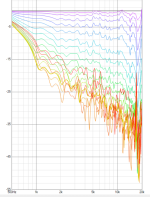
if I remember these are taken without any treatment on the waveguide, just the naked print. Well, since BEM simulation of the waveguide does not show any of the ripple seen in off-axis lines, say between 2kHz and 10kHz, they must be either error associated with measurement rig, or perhaps noise from the implementation, from the print (or something else).
I could assume at least some of it is from the waveguide resonating, which seems to be audible. It is about +/- 0.5db ripple in the graph, so there is some kind of datapoint for magnitude. The ripple does not slide with frequency as angle changes but seems to be mostly the same on any (frontal direction) so it might be from measurement rig, although magnitude changes so parhaps it isn't. Anyway, just speculating about it before more data. After all it's a home measurement so possibility for error is relatively high.
+/-0.5db ripple can be had with ~-30db secondary sound mixed in with direct sound.
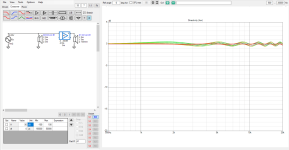
edit. here is the polar graph normalized to 0, 10, 20 and 30 deg.
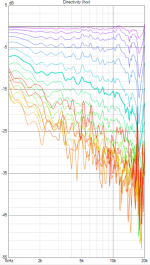
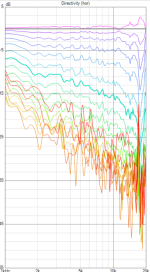
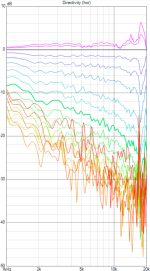
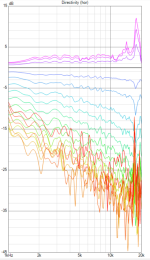
Last edited:
I would try to take a multitone distortion measurement with the "finger technique". Just guessing, but perhaps the resonances of the waveguide itself are not so strong to be obvious in the FR but can modulate the radiated sound enough so that it becomes audible (?).Perhaps I took wrong measurements, perhaps I didn't zoom close enough, perhaps it is below noise floor or something, or the issues is such that it averages out for mic but not for ear. I should try mic measurement with the finger technique, as there is confirmed audible difference perhaps it is possible to now see it on some graphs as well, to get better understanding on magnitude of things.
- Home
- Loudspeakers
- Multi-Way
- Hornflower 2-way point source